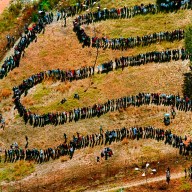Simple question: How can Calgary’s air be ranked good when it looks so brown?
You can see the smoggy haze when driving down into the city, yet 98 per cent of the time our air is ranked good.
There are three monitoring stations in Calgary. Each costs $250,000 and another $50,000 to run annually. A consultant is hired to report data to Alberta Environment.
Our air is measured, Alberta Environment says, on a scale that’s tougher than the national standard.
Yet, both skanky urban air and fresh mountain air get the same rank: Good.
Alberta’s Heart and Lung Association believes our good air is tough on many Albertans. “Good ain’t good,” says CEO Tony Hudson about the Alberta Air Quality Index.
“We see more and more evidence that our so-called good air has a health impact not only for those with respiratory conditions, but also children and women because their lungs are smaller.”
There are signs we need to do more. Calgary’s air has reached what’s known as a “planning trigger” enough times in recent years to force a response.
This means that ozone and particulate matter (tiny particles that lodge in the lungs) are getting too high.
Air management falls to the Calgary Region Airshed Zone (CRAZ), a group of stakeholders.
The city provides space and financing to CRAZ, the province does as well, and the group must come to a consensus about what to do.
Ruling by consensus worries me; especially when we have good air under a sea of brown haze.
To be honest, our air folks really have little power. Most city pollution — 94 per cent, comes from transportation, and our city is growing.
Then there’s home heating emissions, and downstream air from energy operations.
After weighing options, CRAZ’s main plan is to hire a social marketing expert to launch a carpool campaign with a five-year time frame.
This represents a consensus option, when options are so limited.
As economist Kenneth Galbraith notes, there’s little advertising for items in the public sphere — who even knows what our air sensors look like? There’s no YouTube video of docs working on a kid with an asthma attack.
But we need to question an index that pronounces our air good when it doesn’t smell or look that way at all.
















